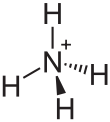Ammonium iodide
Ammonium iodide is the chemical compound NH4I. It is used in photographic chemicals and some medications.[1] It can be prepared by the action of hydroiodic acid on ammonia. It is easily soluble in water, from which it crystallizes in cubes. It is also soluble in ethanol. It gradually turns yellow on standing in moist air, owing to decomposition with liberation of iodine.[1]
| |||
 | |||
| Identifiers | |||
|---|---|---|---|
3D model (JSmol) |
|||
| ChemSpider | |||
| ECHA InfoCard | 100.031.548 | ||
PubChem CID |
|||
| UNII | |||
CompTox Dashboard (EPA) |
|||
| |||
| |||
| Properties | |||
| NH4I | |||
| Molar mass | 144.94 g/mol | ||
| Appearance | White crystalline powder | ||
| Density | 2.51 g/cm3 | ||
| Melting point | 551 °C (1,024 °F; 824 K) (sublimes) | ||
| Boiling point | 235 °C (455 °F; 508 K) (in vacuum) | ||
| 155 g/100 mL (0 °C) 172 g/100 mL (20 °C) 250 g/100 mL (100 °C) | |||
| -66.0·10−6 cm3/mol | |||
| Hazards | |||
| NFPA 704 (fire diamond) | |||
| Flash point | Non-flammable | ||
| Related compounds | |||
Other anions |
Ammonium fluoride Ammonium chloride Ammonium bromide | ||
Other cations |
Sodium iodide Potassium iodide | ||
Except where otherwise noted, data are given for materials in their standard state (at 25 °C [77 °F], 100 kPa). | |||
| Infobox references | |||
Preparation
Ammonium iodide can be made in lab by reacting ammonia or ammonium hydroxide with hydroiodic acid or hydrogen iodide gas:
It is also formed by the decomposition of ammoniated triiodoamine (an explosive).
gollark: We already have two.
gollark: But Compact Machines!
gollark: Me, the Flying Spaghetti Monster, spaceghoti?
gollark: To which god do you swear?
gollark: *hides the evidence*
References
- Holleman, A. F.; Wiberg, E. Inorganic Chemistry Academic Press: San Diego, 2001. ISBN 0-12-352651-5.
This article is issued from Wikipedia. The text is licensed under Creative Commons - Attribution - Sharealike. Additional terms may apply for the media files.

